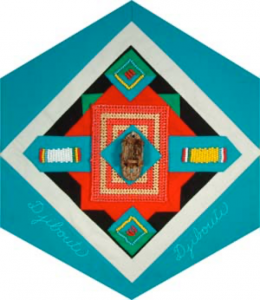Djibouti

The Block
Hanane Abdallah and Asli Merane created four colourfully beaded bands on this block to echo the vibrant shalma (brightly coloured gossamer fabric) Djiboutian women drape around their modest long dresses or skirts. The beadwork and woven piece of raffia around which each band is placed are examples of traditional crafts produced by nomadic groups throughout the country and are prominently displayed on everyday items. The distinctive sandals that have been replicated in miniature at the block’s centre are typical of those worn by the people of Djibouti on a daily basis.
Cultural Profile
Djibouti, formerly French Somaliland, was also once known as the French Territory of the Afars and the Issas. In 1977, the country was granted independence under its current name. This East-African nation, located in the Horn of Africa, is bordered by Eritrea, Ethiopia and Somalia, as well as by the Gulf of Aden and the Red Sea, a location that makes it a strategic place for transport of goods in the region. The ports are the backbone of the country’s economy.
Djibouti’s climate is hot and dry––temperatures range from 25-45 degrees Celsius––and much of the desert-like land supports little agriculture. The country is home to a variety of wildlife, including thousands of flamingos that can be seen in the early morning hours feeding along the shore of Lac Abbé (a salt-lake along the Djibouti-Ethiopia border). The Red Sea, a wonderful site for snorkeling, is also home to an array of beautiful and intriguing underwater species that live around the coral reef.
Djibouti’s population, which is 95 % Muslim, numbers under one million people, and is divided into two main groups: the nomadic Afars (35%) and the Issas or Somali (60%). Europeans (mostly French and Italian), Arabs and Ethiopians make up the small remainder. The two official languages are French and Arabic, although Somali and Afar are widely spoken. French is the official language of education and administration.
Djibouti is a blend of Colonial French and modern Arabic influences. Though many Djiboutian have traded the rural, nomadic way-of-life for the urban environment of Djibouti City (the nation’s capital in which 2/3 of the population live), the country has a rich past which continues to influence the values of their present day life. This can be seen in their practice of hospitality and respect for others. The Afar and Somali languages were historically unwritten, thereby resulting in oral, musical and dance traditions that have become deeply layered and well-developed. In addition, the poetic talents of the Somali have become widely acclaimed through works such as the gabay or the buraanbur.
The Afars have become known for their elaborate gold and silver jewellery. Raffia is used by people still living the nomadic lifestyle for weaving mats and large pieces are used to cover their dome-shaped houses.
In Djibouti, clothing styles play a significant role in proclaiming the wearer’s ethnicity. French people typically wear casual shorts, whereas indigenous groups sport traditional trousers or a sarong-like futa or macawis (for males), or modest, long dresses or skirts layered with a colourful shalma (for females). While the women usually dress in colourful clothes, men habitually wear white clothes.
Djiboutians began immigrating to Canada in the 1980s, leaving behind the civil unrest of their homeland in search of a better life for themselves and their children. To this day however, their numbers remain small.
Sponsor: John and Sue Towndrow
